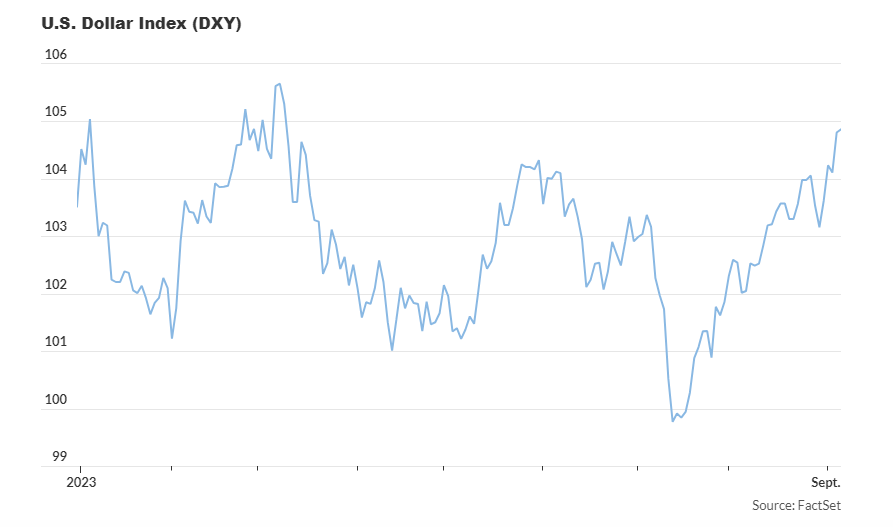Global Jitters: The U.S. Dollar’s Rise and Its Impact on Investments
The strengthening U.S. dollar has raised concerns both internationally and among investors worldwide. However, there is uncertainty regarding the ability of authorities to curb this ascent and its potential to adversely affect U.S. equities.
Edward Moya, a senior market analyst at Oanda, expressed, “The rising value of the dollar is starting to unsettle everyone. Last night, officials from Japan and China attempted to halt the dollar’s surge, but their efforts were unsuccessful.”
Despite warnings from Japanese authorities about potential interventions in currency markets, the Japanese yen continued its decline against the dollar, trading at nearly 148 to the U.S. dollar, marking its lowest level in ten months. Masato Kanda, vice finance minister for international affairs, voiced concerns about the detrimental impact of significant currency fluctuations on both companies and households, stating, “We won’t rule out any option and will take appropriate action if this trend persists.”
Meanwhile, China’s central bank took various steps, including setting a daily reference rate for the yuan higher than expected, in an attempt to bolster the currency as it traded near its weakest level against the dollar since November.
Despite discouraging economic data from Germany, European Central Bank officials remained focused on the potential for further interest rate increases. The euro traded near a three-month low compared to the dollar.
Moya offered insights on the situation, remarking, “Talk about foreign exchange is only effective when supported by compelling data and market conditions that justify decisive and meaningful action.” He also expressed concerns about China’s property crisis and the risks of contagion, noting, “China’s most pressing issues aren’t solely related to the gradual decline of the yuan.”
The ICE U.S. Dollar Index, which measures the dollar’s performance against six major currencies, briefly exceeded the 105 mark for the first time since March, reaching 104.87, a 0.1% increase.
The dollar’s strength can be attributed to robust U.S. economic data, which has positioned the United States more favorably compared to other developed markets. Even if the Federal Reserve has concluded or nearly concluded its interest rate hikes to combat inflation, strong economic data suggests that interest rates are likely to remain elevated. This view gained further support after Saudi Arabia and Russia extended their cuts in crude oil production, pushing Brent crude oil prices back above $90 per barrel.

Rising oil prices led to an increase in Treasury yields, which enhanced the dollar’s appeal.
Nevertheless, concerns about rising yields and the trajectory of Fed interest rates weighed on U.S. stocks during the week, with both the S&P 500 and the Dow Jones Industrial Average experiencing declines.
For stock market investors, a strong dollar can present challenges, especially for companies heavily reliant on overseas sales, as it makes their exports more expensive for foreign buyers. However, it appears that the current movements of the dollar are not yet causing significant issues.
Ross Mayfield, an investment strategy analyst at Baird Private Wealth Management, believes that the current surge in the dollar is more likely a temporary uptick within a broader downtrend rather than a sustained rally. While the dollar had experienced a significant increase in 2022, causing disruptions in financial markets, the ICE U.S. Dollar Index, although trading near a six-month high, remains nearly 5% lower than its level from a year ago and has decreased by 8.6% from its peak reached in the fall of the previous year, which was just below 115.
Mayfield speculates that the dollar is likely to stabilize and eventually weaken, rather than continue its recent rally. He suggests that significant concerns would only emerge if the dollar index were to break through and reach new highs in 2023, potentially revisiting the peaks seen in late 2022.




